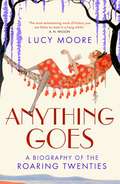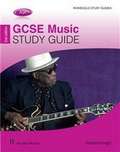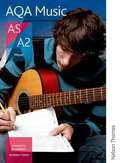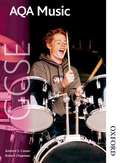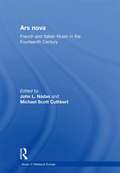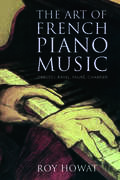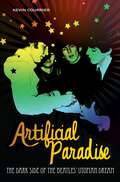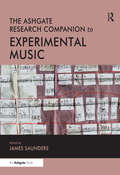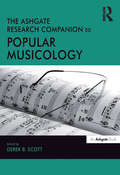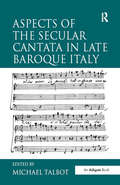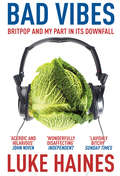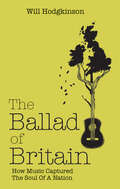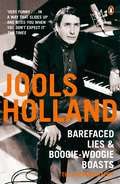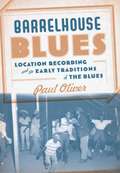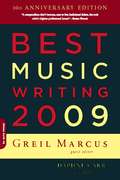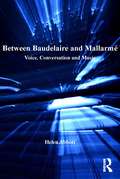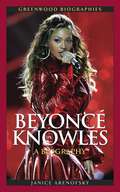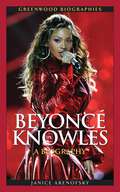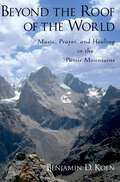- Table View
- List View
Anything Goes: A Biography of the Roaring Twenties
by Lucy MooreBracketed by the catastrophes of the Great War and the Wall Street Crash, 1920s America was a place of drama, tension and hedonism. It glittered and seduced: jazz, flappers, wild all-night parties, the birth of Hollywood, and a glamorous gangster-led crime scene flourishing under prohibition. But the period was also punctuated by momentous events - the political show trials of Sacco and Vanzetti; the huge Ku Klux Klan march down Washington DC's Pennsylvania Avenue - and it produced a splendid array of writers, musicians and film stars, from F. Scott Fitzgerald to Bessie Smith and Charlie Chaplin.
Aqa Gcse Music (PDF)
by Richard KnightThis guide, specially written for the new AQA GCSE specification, covers everything students need to know to succeed in the examinations and through their coursework.
AQA Music AS/A2: Student Book (PDF)
by Andrew Coxon Rosemary BroadbentAQA Music is the only set of resources to have been developed with, and exclusively endorsed by, AQA, making them the first choice to support the new AQA specification for A Level.
AQA Music GCSE: Student Book (PDF)
by Coxon Andrew Redding Philip Chapman BobAQA GCSE Music is the only resource to have been developed with and exclusively endorsed by AQA. With a real focus on tracking individual progress, you can improve your students' chance of exam success through a unique blend of print and electronic resources.
Ars nova: French and Italian Music in the Fourteenth Century
by John L. Nádas Michael Scott CuthbertIn the early fourteenth century, musicians in France and later Italy established new traditions of secular and sacred polyphony. This ars nova, or "new art," popularized by theorists such as Philippe de Vitry and Johannes de Muris was the among the first of many later movements to establish the music of the present as a clean break from the past. The rich music of this period, by composers such as Guillaume de Machaut and Francesco Landini, is not only beautiful, but also rewards deep study and analysis. Yet contradictions and gaps abound in the ars nova of the fourteenth and early fifteenth centuries-how do we read this music? how do we perform this music? what was the cultural context of these performances? These problems are well met by the ingenuity of approaches and solutions found by scholars in this volume. The twenty-seven articles brought together reflect the broad methodological and chronological range of scholarly inquiry on the ars nova.
Ars nova: French and Italian Music in the Fourteenth Century
by John L. Nádas Michael Scott CuthbertIn the early fourteenth century, musicians in France and later Italy established new traditions of secular and sacred polyphony. This ars nova, or "new art," popularized by theorists such as Philippe de Vitry and Johannes de Muris was the among the first of many later movements to establish the music of the present as a clean break from the past. The rich music of this period, by composers such as Guillaume de Machaut and Francesco Landini, is not only beautiful, but also rewards deep study and analysis. Yet contradictions and gaps abound in the ars nova of the fourteenth and early fifteenth centuries-how do we read this music? how do we perform this music? what was the cultural context of these performances? These problems are well met by the ingenuity of approaches and solutions found by scholars in this volume. The twenty-seven articles brought together reflect the broad methodological and chronological range of scholarly inquiry on the ars nova.
The Art of French Piano Music: Debussy, Ravel, Fauré, Chabrier
by Roy HowatAn essential resource for scholars and performers, this study by a world-renowned specialist illuminates the piano music of four major French composers, in comparative and reciprocal context. Howat explores the musical language and artistic ethos of this repertoire, juxtaposing structural analysis with editorial and performing issues. He also relates his four composers historically and stylistically to such predecessors as Chopin, Schumann, Liszt, the French harpsichord school, and Russian and Spanish music. Challenging long-held assumptions about performance practice, Howat elucidates the rhythmic vitality and invention inherent in French music. In granting Fauré and Chabrier equal consideration with Debussy and Ravel, he redresses a historic imbalance and reshapes our perceptions of this entire musical tradition. Outstanding historical documentation and analysis are supported by Howat’s direct references to performing traditions shaped by the composers themselves. The book balances accessibility with scholarly and analytic rigor, combining a lifetime’s scholarship with practical experience of teaching and the concert platform
Artificial Paradise: The Dark Side of the Beatles' Utopian Dream (Non-ser.)
by Kevin CourrierThere is an epigram in this book from the Phil Ochs song, "Crucifixion", about the Kennedy assassination, that states: I fear to contemplate that beneath the greatest love, lies a hurricane of hate. On February 11th 1963, the Beatles recorded "There's a Place", a dazzling, unheralded tune which was included on their electrifying debut album, Please Please Me. This song firmly laid the foundation on which a huge utopian dream of the sixties would be built. Within that dream, however, also lay the seeds of a darker vision that would emerge out of the very counterculture that the Beatles and their music helped create. Thus, even as their music attracted adoring fans, it also enticed the murderous ambitions of Charles Manson; and though the Beatles may have inspired others to form bands, their own failed hopes ultimately led to their breakup.The disillusionment with the sixties, and the hopes associated with the group, would many years later culminate in the assassination of John Lennon and the attempted slaying of George Harrison by deranged and obsessive fans. In this incisive examination, author Kevin Courrier (Dangerous Kitchen: the Subversive World of Zappa, Randy Newman's American Dreams) examines how the Fab Four, through their astonishing music and comically rebellious personalities, created the promise of an inclusive culture built on the principles of pleasure and fulfillment. By taking us through their richly inventive catalogue, Courrier illustrates how the Beatles' startling impact on popular culture built a bond with audiences that was so strong, people today continue to either cling nostalgically to it, or struggle - and often struggle violently - to escape its influence.
The Ashgate Research Companion to Experimental Music (Routledge Music Companions)
by James SaundersThe recent resurgence of experimental music has given rise to a more divergent range of practices than has previously been the case. The Ashgate Research Companion to Experimental Music reflects these recent developments by providing examples of current thinking and presenting detailed case studies that document the work of contemporary figures. The book examines fourteen current practitioners by interrogating their artistic practices through annotated interviews, contextualized by nine authored chapters which explore central issues that emerge from and inform these discussions. Whilst focusing on composition, the book also encompasses related aspects of performance, improvisation and sonic art. The interviews all explore how the selected artists work, focusing on the processes involved in developing their recent projects, set against more general aesthetic concerns. They aim to shed light on the disparate nature of current work whilst seeking to find possible points of contact. Many of the practitioners are active in areas that span disciplines, such as composition and improvisation, and the book explores the interaction of these activities in the context of their work. The other chapters consider a range of issues pertinent to recent developments in the genre, including: definitions of experimentalism and its relationship with a broader avant garde; experimentalism and cultural change; notation and its effect on composition; realising open scores; issues of notation and interpretation in live electronic music; performing experimental music; improvisation and technology; improvisation and social meaning; instrumentalizing objects; visual artists' relationships to experimental music; working across interdisciplinary boundaries; listening and the soundscape; working methods, techniques and aesthetics of recent experimental music.
The Ashgate Research Companion to Experimental Music (Routledge Music Companions)
by James SaundersThe recent resurgence of experimental music has given rise to a more divergent range of practices than has previously been the case. The Ashgate Research Companion to Experimental Music reflects these recent developments by providing examples of current thinking and presenting detailed case studies that document the work of contemporary figures. The book examines fourteen current practitioners by interrogating their artistic practices through annotated interviews, contextualized by nine authored chapters which explore central issues that emerge from and inform these discussions. Whilst focusing on composition, the book also encompasses related aspects of performance, improvisation and sonic art. The interviews all explore how the selected artists work, focusing on the processes involved in developing their recent projects, set against more general aesthetic concerns. They aim to shed light on the disparate nature of current work whilst seeking to find possible points of contact. Many of the practitioners are active in areas that span disciplines, such as composition and improvisation, and the book explores the interaction of these activities in the context of their work. The other chapters consider a range of issues pertinent to recent developments in the genre, including: definitions of experimentalism and its relationship with a broader avant garde; experimentalism and cultural change; notation and its effect on composition; realising open scores; issues of notation and interpretation in live electronic music; performing experimental music; improvisation and technology; improvisation and social meaning; instrumentalizing objects; visual artists' relationships to experimental music; working across interdisciplinary boundaries; listening and the soundscape; working methods, techniques and aesthetics of recent experimental music.
The Ashgate Research Companion to Popular Musicology (Routledge Music Companions)
by Derek B. ScottThe research presented in this volume is very recent, and the general approach is that of rethinking popular musicology: its purpose, its aims, and its methods. Contributors to the volume were asked to write something original and, at the same time, to provide an instructive example of a particular way of working and thinking. The essays have been written with a view to helping graduate students with research methodology and the application of relevant theoretical models. The team of contributors is an exceptionally strong one: it contains many of the pre-eminent academic figures involved in popular musicological research, and there is a spread of European, American, Asian, and Australasian scholars. The volume covers seven main themes: Film, Video and Multimedia; Technology and Studio Production; Gender and Sexuality; Identity and Ethnicity; Performance and Gesture; Reception and Scenes and The Music Industry and Globalization. The Ashgate Research Companion is designed to offer scholars and graduate students a comprehensive and authoritative state-of-the-art review of current research in a particular area. The companion's editor brings together a team of respected and experienced experts to write chapters on the key issues in their speciality, providing a comprehensive reference to the field.
The Ashgate Research Companion to Popular Musicology (Routledge Music Companions)
by Derek B. ScottThe research presented in this volume is very recent, and the general approach is that of rethinking popular musicology: its purpose, its aims, and its methods. Contributors to the volume were asked to write something original and, at the same time, to provide an instructive example of a particular way of working and thinking. The essays have been written with a view to helping graduate students with research methodology and the application of relevant theoretical models. The team of contributors is an exceptionally strong one: it contains many of the pre-eminent academic figures involved in popular musicological research, and there is a spread of European, American, Asian, and Australasian scholars. The volume covers seven main themes: Film, Video and Multimedia; Technology and Studio Production; Gender and Sexuality; Identity and Ethnicity; Performance and Gesture; Reception and Scenes and The Music Industry and Globalization. The Ashgate Research Companion is designed to offer scholars and graduate students a comprehensive and authoritative state-of-the-art review of current research in a particular area. The companion's editor brings together a team of respected and experienced experts to write chapters on the key issues in their speciality, providing a comprehensive reference to the field.
Aspects of the Secular Cantata in Late Baroque Italy
by Michael TalbotAs shown by the ever-increasing volume of recordings, editions and performances of the vast repertory of secular cantatas for solo voice produced, primarily in Italy, in the second half of the seventeenth century and the first half of the eighteenth century, this long neglected genre has at last 'come of age'. However, scholarly interest is currently lagging behind musical practice: incredibly, there has been no general study of the Baroque cantata since Eugen Schmitz's handbook of 1914, and although many academic theses have examined microscopically the cantatas of individual composers, there has been little opportunity to view these against the broader canvas of the genre as a whole. The contributors in this volume choose aspects of the cantata relevant to their special interests in order to say new things about the works, whether historical, analytical, bibliographical, discographical or performance-based. The prime focus is on Italian-born composers working between 1650 and 1750 (thus not Handel), but the opportunity is also taken in one chapter (by Graham Sadler) to compare the French cantata tradition with its Italian parent in association with a startling new claim regarding the intended instrumentation. Many key figures are considered, among them Tomaso Albinoni, Giovanni Bononcini, Giovanni Legrenzi, Benedetto Marcello, Alessandro Scarlatti, Alessandro Stradella, Leonardo Vinci and Antonio Vivaldi. The poetic texts of the cantatas, all too often treated as being of little intrinsic interest, are given their due weight. Space is also found for discussions of the history of Baroque solo cantatas on disc and of the realization of the continuo in cantata arias - a topic more complex and contentious than may at first be apparent. The book aims to stimulate interest in, and to win converts to, this genre, which in its day equalled the instrumental sonata in importance, and in which more than a few composers invested a major part of their creativity.
Aspects of the Secular Cantata in Late Baroque Italy
by Michael TalbotAs shown by the ever-increasing volume of recordings, editions and performances of the vast repertory of secular cantatas for solo voice produced, primarily in Italy, in the second half of the seventeenth century and the first half of the eighteenth century, this long neglected genre has at last 'come of age'. However, scholarly interest is currently lagging behind musical practice: incredibly, there has been no general study of the Baroque cantata since Eugen Schmitz's handbook of 1914, and although many academic theses have examined microscopically the cantatas of individual composers, there has been little opportunity to view these against the broader canvas of the genre as a whole. The contributors in this volume choose aspects of the cantata relevant to their special interests in order to say new things about the works, whether historical, analytical, bibliographical, discographical or performance-based. The prime focus is on Italian-born composers working between 1650 and 1750 (thus not Handel), but the opportunity is also taken in one chapter (by Graham Sadler) to compare the French cantata tradition with its Italian parent in association with a startling new claim regarding the intended instrumentation. Many key figures are considered, among them Tomaso Albinoni, Giovanni Bononcini, Giovanni Legrenzi, Benedetto Marcello, Alessandro Scarlatti, Alessandro Stradella, Leonardo Vinci and Antonio Vivaldi. The poetic texts of the cantatas, all too often treated as being of little intrinsic interest, are given their due weight. Space is also found for discussions of the history of Baroque solo cantatas on disc and of the realization of the continuo in cantata arias - a topic more complex and contentious than may at first be apparent. The book aims to stimulate interest in, and to win converts to, this genre, which in its day equalled the instrumental sonata in importance, and in which more than a few composers invested a major part of their creativity.
Bad Vibes: Britpop and my part in its downfall
by Luke HainesForget Blur/Oasis and Cool Britannia. None of that actually happened. Bad Vibes is the true story of English Rock in the nineties. Written with wit, brio and no small amount of bile, Luke Haines recounts how it felt to ride a wave of self-congratulatory success in a world with no taste. As frontman of The Auteurs, Haines tells of supporting Suede, conquering France, and failing to break America. Of knuckle-headed musos , baffling tours and a swiftly unravelling personal life. And of what it's like to be on the cusp of massive success. Funny, honest and ridiculously entertaining, Luke Haines attacks anyone within rifle range, and is more than happy to turn the gun on himself. Bad Vibes is a brilliant memoir from a man who tells it how it was - and how he wishes it hadn't been.
The Ballad of Britain: How Music Captured The Soul Of A Nation
by Will HodgkinsonIn 1903, the Victorian composer Cecil Sharp began a decade-long journey to collect folk songs that, he believed, captured the spirit of Great Britain. A century later, with the musical and cultural map of the country transformed, writer and journalist Will Hodgkinson sets out on a similar journey to find the songs that make up modern Britain. He looks at the unique relationship the British have with music, and tries to understand how the country has represented itself through song. He visits remote pubs in the West Country where families have been passing down local songs for generations, monasteries in Oxfordshire where monks use plainsong to commune with God, sits in with Hindu devotional singers in the suburbs of Birmingham and learns an ancient folk tune from a Sussex farmer. Will goes from the heart of the mainstream music scenes to the very fringes as part of his quest, visiting in turn remote musical heartlands and great urban musical cities. London (The Kinks, The Who and Blur), Liverpool (The Teardrop Explodes, Echo & The Bunnymen, The Beatles), Manchester (Joy Division, Stone Roses, Oasis) and Sheffield (Cabaret Voltaire, The Human League, Pulp and more recently, The Arctic Monkeys) all feature prominently as the respective homes of clusters of great bands that have helped shape the British musical landscape. An engaging blend of humour and musical scholarship, The Ballad of Britian is as much a portrait of Britain as an adventure into lyric and melody. The project forced the author into an itinerant life, scouring the length and breadth of the country for singers and songwriters in an attempt to discover whether songs still travel the way they once did, to find out whether folk music still exists in a meaningful sense, and to see how regional variations contribute to a collective musical ''Britishness''.
Barefaced Lies and Boogie-Woogie Boasts
by Harriet Vyner Jools HollandJools Holland has had a fascinating life. From playing on bomb sites as a boy in the East End, to skiving off school and then selling millions of records with Squeeze, the first twenty years of his life were eventful, chaotic and colourful. Then came The Tube with Paula Yates, the seminal live music programme that propelled him to fame. Over the following three decades, Jools succeeded in placing himself at the epicentre of a global community comprising just about anybody who is anybody in music. Through Later with Jools Holland, the longest-running music programme on television, he has given British TV debuts to countless now world famous bands. Packed with hilarious anecdotes written in Holland’s own inimitable style and laced with quirky insights and deliciously acute detail, this autobiography by one of Britain’s most gifted and debonaire musicians is not just for music fans, but for anyone who is looking for something several cuts above the conventional showbiz memoir.
Barrelhouse Blues: Location Recording and the Early Traditions of the Blues
by Paul OliverIn the 1920s, Southern record companies ventured to cities like Dallas, Atlanta, and New Orleans, where they set up primitive recording equipment in makeshift studios. They brought in street singers, medicine show performers, pianists from the juke joints and barrelhouses. The music that circulated through Southern work camps, prison farms, and vaudeville shows would be lost to us if it hadn't been captured on location by these performers and recorders.Eminent blues historian Paul Oliver uncovers these folk traditions and the circumstances under which they were recorded, rescuing the forefathers of the blues who were lost before they even had a chance to be heard. A careful excavation of the earliest recordings of the blues by one of its foremost experts, Barrelhouse Blues expands our definition of that most American style of music.
Behind The Glass: Top Record Producers Tell How They Craft The Hits VOL II (PDF)
by Howard MasseyÊBehind the Glass Volume IIÊ presents another prime collection of firsthand interviews with the world's top record producers and engineers sharing their creative secrets and hit-making techniques ä from the practical to the artistic. In these pages you'll find ±Daniel Lanois± (U2 Bob Dylan) discussing the future of digital recording; ±T-Bone Burnett± (Robert Plant and Alison Krauss) sharing his unique view of creating complex low end; and ±Hugh Padgham± (Police Genesis) analyzing the state of the business today. For real-world advice on everything from home recording to mixing to coaching a nervous singer check out author Howard Massey's conversations with ±Mark Ronson± (Amy Winehouse) ±Tony Brown± (Reba McEntire) ±Gus Dudgeon± (Elton John) ±John Simon± (The Band) ±Russ Titelman± (Steve Winwood) ±Bruce Swedien± (Michael Jackson) ±Rodney Jerkins± (Mary J. Blige) ±Simon Climie± (Eric Clapton) ±Matt Serletic± (Matchbox Twenty) and more.
Best Music Writing 2009
by Greil MarcusBest Music Writing has faithfully collected the year's most compelling writing on music for a decade now, so it's appropriate this special edition be guest-edited by one of the best-known writers on music and popular culture, Greil Marcus, author of Lipstick Traces, Mystery Train, Like a Rolling Stone, and other groundbreaking excursions into the very fabric of music, America, and beyond.As always, Series Editor Daphne Carr has culled an impressively wide range of essays, profiles, news articles, interviews, creative non-fiction, fiction, book reviews, long-format reviews, blog posts, and journal articles on music and music culture, from rock and hip-hop to R&B and jazz to pop, blues, and more. Writers who have been published in Best Music Writing include Alex Ross, Jonathan Lethem, Ann Powers, Dave Eggers, Susan Orlean, and more.
Between Baudelaire and Mallarmé: Voice, Conversation and Music
by Helen AbbottAs the status of poetry became less and less certain over the course of the nineteenth century, poets such as Baudelaire and Mallarmé began to explore ways to ensure that poetry would not be overtaken by music in the hierarchy of the arts. Helen Abbott examines the verse and prose poetry of these two important poets, together with their critical writings, to address how their attitudes towards the performance practice of poetry influenced the future of both poetry and music. Central to her analysis is the issue of 'voice', a term that remains elusive in spite of its broad application. Acknowledging that voice can be physical, textual and symbolic, Abbott explores the meaning of voice in terms of four categories: (1) rhetoric, specifically the rules governing the deployment of voice in poetry; (2) the human body and its effect on how voice is used in poetry; (3) exchange, that is, the way voices either interact or fail to interact; and (4) music, specifically the question of whether poetry should be sung. Abbott shows how Baudelaire and Mallarmé exploit the complexity and instability of the notion of voice to propose a new aesthetic that situates poetry between conversation and music. Voice thus becomes an important process of interaction and exchange rather than something stable or static; the implications of this for Baudelaire and Mallarmé are profoundly significant, since it maps out the possible future of poetry.
Between Baudelaire and Mallarmé: Voice, Conversation and Music
by Helen AbbottAs the status of poetry became less and less certain over the course of the nineteenth century, poets such as Baudelaire and Mallarmé began to explore ways to ensure that poetry would not be overtaken by music in the hierarchy of the arts. Helen Abbott examines the verse and prose poetry of these two important poets, together with their critical writings, to address how their attitudes towards the performance practice of poetry influenced the future of both poetry and music. Central to her analysis is the issue of 'voice', a term that remains elusive in spite of its broad application. Acknowledging that voice can be physical, textual and symbolic, Abbott explores the meaning of voice in terms of four categories: (1) rhetoric, specifically the rules governing the deployment of voice in poetry; (2) the human body and its effect on how voice is used in poetry; (3) exchange, that is, the way voices either interact or fail to interact; and (4) music, specifically the question of whether poetry should be sung. Abbott shows how Baudelaire and Mallarmé exploit the complexity and instability of the notion of voice to propose a new aesthetic that situates poetry between conversation and music. Voice thus becomes an important process of interaction and exchange rather than something stable or static; the implications of this for Baudelaire and Mallarmé are profoundly significant, since it maps out the possible future of poetry.
Beyoncé Knowles: A Biography (Greenwood Biographies)
by Janice ArenofskyAlthough Beyoncé Knowles is not yet 30, the sensual superstar has already succeeded on many levels: as a dancer, singer, composer, model, music producer, video director and actress. Like rap star/entrepreneur Jay-Z, with whom Beyoncé recently married, she has evolved into a businesswoman, who with her designer-mother, Tina Knowles, markets Beyoncé's personal fashion line, House of Dereon. The multi-talented, global entertainer lends her name and image to many commercial and philanthropic ventures. She is the spokeswoman for L'Oreal and appears in ads for Pepsi and Ford.This biography tells the story of a young, talented woman's meteoric rise in the entertainment industry. From a shy, demure Catholic schoolgirl growing up in Houston, Texas, Beyoncé Knowles eventually morphed into the first African-American woman to win the Songwriter of the Year Award from the American Society of Composers, Authors and Publishers Pop Music Awards. The once-shy suburban schoolgirl has gone far beyond her original dream of becoming a first-rate musician and vocalist. With the assistance of her manager-father—former Xerox executive Mathew Knowles—and as lead singer of the R&B girl group Destiny's Child (the world's all-time bestselling female group), Beyoncé has won 10 Grammy Awards and two Golden Globe nominations. Her albums have reached more than 20 million people worldwide, and she has become a cultural icon to music lovers everywhere as well as a role model for young women. Author Janice Arenofsky gives students and general readers alike an insightful look at a music and fashion icon who has a unique niche in popular culture today. Complete with photos, a timeline, and a thorough bibliography.
Beyoncé Knowles: A Biography (Greenwood Biographies)
by Janice ArenofskyAlthough Beyoncé Knowles is not yet 30, the sensual superstar has already succeeded on many levels: as a dancer, singer, composer, model, music producer, video director and actress. Like rap star/entrepreneur Jay-Z, with whom Beyoncé recently married, she has evolved into a businesswoman, who with her designer-mother, Tina Knowles, markets Beyoncé's personal fashion line, House of Dereon. The multi-talented, global entertainer lends her name and image to many commercial and philanthropic ventures. She is the spokeswoman for L'Oreal and appears in ads for Pepsi and Ford.This biography tells the story of a young, talented woman's meteoric rise in the entertainment industry. From a shy, demure Catholic schoolgirl growing up in Houston, Texas, Beyoncé Knowles eventually morphed into the first African-American woman to win the Songwriter of the Year Award from the American Society of Composers, Authors and Publishers Pop Music Awards. The once-shy suburban schoolgirl has gone far beyond her original dream of becoming a first-rate musician and vocalist. With the assistance of her manager-father—former Xerox executive Mathew Knowles—and as lead singer of the R&B girl group Destiny's Child (the world's all-time bestselling female group), Beyoncé has won 10 Grammy Awards and two Golden Globe nominations. Her albums have reached more than 20 million people worldwide, and she has become a cultural icon to music lovers everywhere as well as a role model for young women. Author Janice Arenofsky gives students and general readers alike an insightful look at a music and fashion icon who has a unique niche in popular culture today. Complete with photos, a timeline, and a thorough bibliography.
Beyond the Roof of the World: Music, Prayer, and Healing in the Pamir Mountains
by Benjamin D. KoenWhile Western medicine has conventionally separated music, science, and religion into distinct entities, traditional cultures throughout the world have always viewed music as a bridge that connects the physical with the spiritual. Now, as people in even the most technologically advanced nations across the globe struggle with obtaining affordable and reliable healthcare coverage, more and more people are turning to these ancient cultural practices of ICAM healing (integrative, complementary, and alternative medicine). With Beyond the Roof of the World, Dr. Benjamin D. Koen unearths the Western separation of healing from spiritual and musical practices as a culturally determined phenomenon, and proves the relevance of medical ethnomusicology in light of the globally spreading ICAM healing practices. Using the culture found within the towering Pamir Mountains of Badakhshan Tajikistan, in a place poetically known as the Roof of the World, as the paradigm of ICAM healing, Koen shows spirituality and musicality to be intimately intertwined with one's physical life, health and healing. For the first time, Koen bridges the widespread gap between ethnomusicology and music therapy. Koen's extensive research and emersion into the Badakhstan culture provides the reader with an "insider" perspective while maintaining an "observer's" view, as he infuses the text with relevant scholarship.
